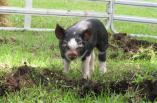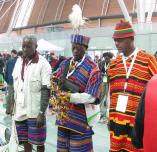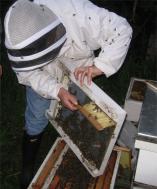ASLE plenary speakers were wide-ranging and various, and I didn’t always have my notebook handy. Una Chaudhuri and Helen Tiffin were the first I heard, on Wednesday. During Chaudhuri’s talk we watched Mesocosm playing out in the background (and heard that the figure in it is modelled on Leigh Bowery, which brought a few random things together for me: having arrived in England in the decade after his glory days, I’d only known of him because of Lucien Freud’s paintings)
Thursday’s plenary speaker Marc Bekoff was stranded because of airport disruptions, so he joined us from his wilderness hideaway by skype, which worked remarkably well, all things considered. He spoke generally about his work which has led to such publications as The Animal Manifesto and Animals at Play: Rules of the Game (which he said brought together his 30 years of research into play behaviour). But his theme, animal compassion, he summarized by saying “Anyone who says that life matters less to animal than our life means to us has never held in their hands an animal fighting for its life.”
He observed that humans have a confusing relationship with animals: claim to love them and yet hunt them or rear them in factory farms, and generally treat them in ways we wouldn’t treat a family pet. They’re very much like us, he said, but also different. Speciesism doesn’t work as a way of establishing a natural hierarchy, where we assign higher and lower designations to animal life using ourselves as a template, because in fact they do a lot of things better than us.
In the Q&A he was asked his opinion of Temple Grandin, which he answered carefully, saying they had met, and that they’d agreed to disagree. He acknowledged her work by saying she’s improved the lives of a minute fraction of the animals who go to slaughter, and acknowledged her “amazing effect,” with which she reaches a very wide audience, informs people about animal sentience. But in Bekoff’s view, she’s not improving the well-being of animals, and it is worth remembering she’s paid by the meat industry.
Next up was environmental lawyer Robert L. Fischman, who teaches at Indiana University Bloomington, and is known among environmentalists for his writings on animal migrations, spoke on themes that affect environmental law at present.
Climate change, he said, currently dominates scholarship and rule making. And observed that in environmental law there is a stark division between people studying pollution control, viewing the environment as a sink; and those studying conservation on other hand , viewing the environment as a treasure trove for goods (natural resources). Pollution control law grew out of public health concerns, while resource management is more rooted in judgements made law, and undergoes conservative incremental change, with changes in ideas of ownership and property.
Which led to discussion of land trusts, the big environmental issue in the US today. In 1980 there were about a tenth of a million acres in trust; tax laws changed around then and so did the interest in land trusts. By 2003 there were 5 million acres, and in 2005 some 12 million acres; and it’s probably doubled since then. Land trusts are a relatively new species of property right, placing values on land and water rather than on the monetary value of land for transformative development use.
Initially, land trusts were isolated zoo-like reserves, but they became stepping stones, and then lines on a map. By the 1980s, biology had taught us that webs of conservation are importan, so reserves must be nodes in a network. The realities of what we’ve already observed in climate change on land and what changes we anticipate mean that connecting our landscape will be very important in allowing both animals and ecological services to adapt and be resilient to climate change.
Bringing it home to the audience, he pointed out that in environmental law and policy, interdisciplinary work means working with social and natural scientists, not scholars from the arts and humanities. Yet what passes for research in this field really is related to the humanities: you search sources and make arguments based on your findings. Storytelling and rhetoric became uniquely important tools in this particular area of law.
Finally, he said, we need to think through to resilience issues rather than stopping with conservation of the present: for example, we have halted the species elimination of buffalo, but eliminated the migration aspects of their lives. We need to safeguard migration corridors as well as habitat. This “connectivity” is too broad a concept to capture public support, but migration conservation is a concept that might be possible to use to promote a more holistic cause.
In the Q&A, the topic of mountaintop removal in the coal industry came up; timely subject for this Vancouver Islander. Is this, the questioner wondered, as corrupt an industry as it seemed? Stepping lightly through his answer, Fischman chose instead to observe that this area rather demonstrates what a clumsy tool the clean water act is to use on mining and mountaintops.He noted that the Obama administration had at least revoked nationwide permits allowing free mountaintop removal. But the clean water act saved as much of the High Sierra as has been saved; negotiated solutions are still needed.









